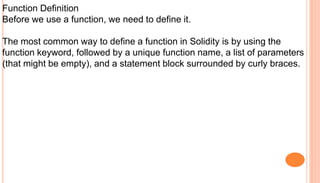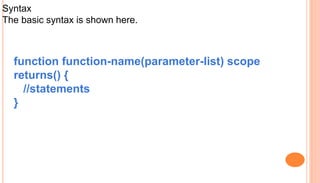Solidity is a high-level programming language designed for writing smart contracts on the Ethereum blockchain, resembling JavaScript syntax. It encompasses key concepts such as contracts, storage locations, value types, data structures, and control flow mechanisms. The language supports multiple inheritance, modifiers, and various operators while also providing a framework for defining contract behaviors and interactions.














![Arrays
Arrays in Solidity can have a compile-time fixed size or they can be dynamic.
1 uint[3] fixed; //array of fixed length 3
1
uint[] dynamic; //a dynamic array has no fixed size, it can
keep growing
You can also create an array of structs. Using the previously created Voter struct:
Note: declaring an array as public will automatically create a better method for it
1 Voter[] voting;
1 Voter[] public voting;](https://image.slidesharecdn.com/solidityprogramming-231020041811-37587de4/85/solidity-programming-pptx-15-320.jpg)
![Mappings
Mappings can be seen as hash tables which are virtually initialized such that every possible key exists and is
mapped to a value whose byte-representation is all zeros: a type’s default value.
Mappings are declared as:
1 Mapping(_Keytype => _ValueType )
Note: _Keytype can be almost any type except for a dynamically sized array, a contract, an enum and a
struct.
Example:
1
2
3
4
5
6
7
8
9
10
contract MappingExample {
mapping(address => uint) public balances;
function update(uint newBalance) {
balances[msg.sender] = newBalance; }}
contract MappingUser {
function f() returns (uint) {
MappingExample m = new MappingExample();
m.update(100);
return m.balances(this);
}}](https://image.slidesharecdn.com/solidityprogramming-231020041811-37587de4/85/solidity-programming-pptx-16-320.jpg)













![if (_i == 0) { //comparison operator
return "0";
}
uint j = _i;
uint len;
while (j != 0) { //comparison operator
len++;
j /= 10;
}
bytes memory bstr = new bytes(len);
uint k = len - 1;
while (_i != 0) {
bstr[k--] = byte(uint8(48 + _i % 10));
_i /= 10;
}
return string(bstr);//access local variable
}](https://image.slidesharecdn.com/solidityprogramming-231020041811-37587de4/85/solidity-programming-pptx-30-320.jpg)


![Syntax
The syntax of while loop in Solidity is as follows −
while (expression) {
Statement(s) to be executed if expression is true
}
pragma solidity =0.5.0 <= 0.9.0;
contract array
{
uint[3] public arr;
uint public count;
function loop() public{
while(count<arr.length)
{
arr[count] = count;
count++;
}
}
}](https://image.slidesharecdn.com/solidityprogramming-231020041811-37587de4/85/solidity-programming-pptx-33-320.jpg)


![// Solidity program to
// demonstrate the use of
// 'Do-While loop'
pragma solidity ^0.5.0;
// Creating a contract
contract Types {
// Declaring a dynamic array
uint[] data;
// Declaring state variable
uint8 j = 0;
// Defining function to demonstrate
// 'Do-While loop'
function loop(
) public returns(uint[] memory){
do{
j++;
data.push(j);
}while(j < 5) ;
return data;
}
}](https://image.slidesharecdn.com/solidityprogramming-231020041811-37587de4/85/solidity-programming-pptx-36-320.jpg)


![// Solidity program to
// demonstrate the use
// of 'For loop'
pragma solidity ^0.5.0;
// Creating a contract
contract Types {
// Declaring a dynamic array
uint[] data;
// Defining a function
// to demonstrate 'For loop'
function loop(
) public returns(uint[] memory){
for(uint i=0; i<5; i++){
data.push(i);
}
return data;
}
}](https://image.slidesharecdn.com/solidityprogramming-231020041811-37587de4/85/solidity-programming-pptx-39-320.jpg)





![Mapping Types
Mapping types are the most used reference type; they are used to store data in a key-value pair; where
the key can be any built-in value types or byte and string. You can think of it as a hash table or dictionary
as in any other language, in which a user can store data in a key-value format and data can be retrieved
by key.
mapping(_KeyType => _ValueType) <access specifier> <name>;
Example
mapping (address => uint) account;
pragma solidity ^0.5.0;
contract MappingExample {
mapping(address => uint) account;
function updateBalance(uint newBalance) public {
account[msg.sender] = newBalance;
}
function getBalance(address _address)
public view returns (uint) {
return account[_address];
}
}](https://image.slidesharecdn.com/solidityprogramming-231020041811-37587de4/85/solidity-programming-pptx-45-320.jpg)








